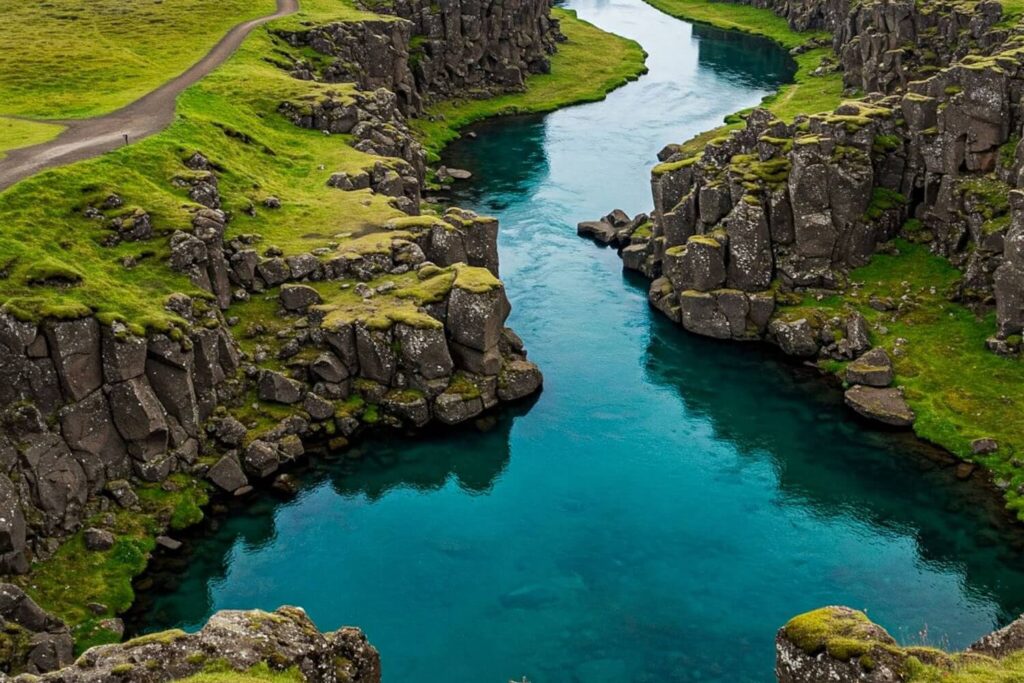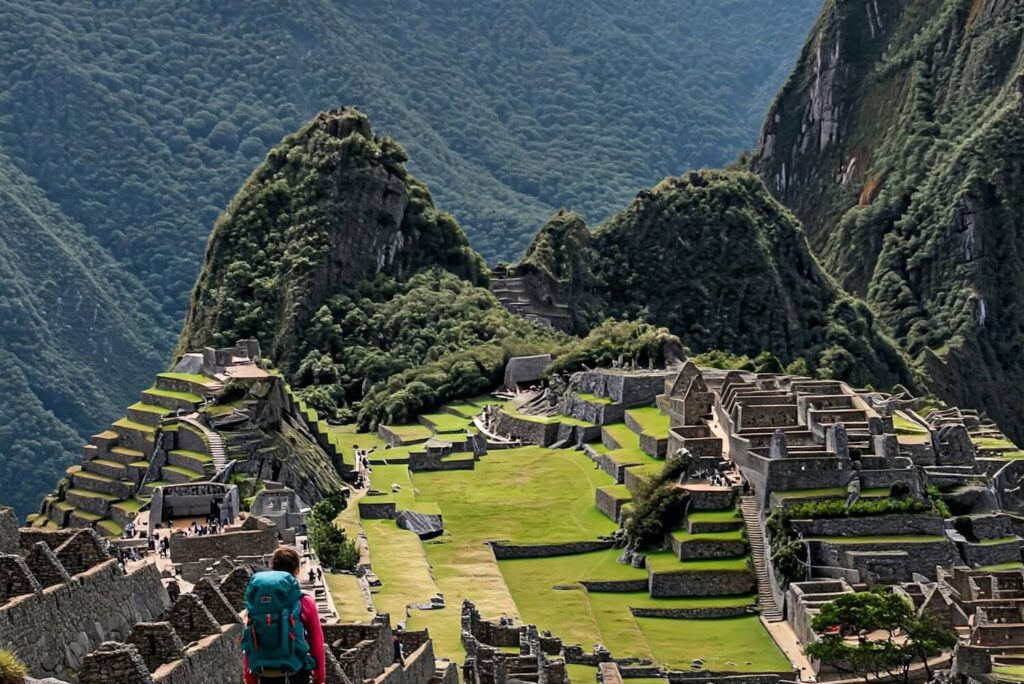Introduction to the Golden Circle
Situated in the southwestern region of Iceland, the Golden Circle is a renowned tourist route that showcases some of the country’s most breathtaking natural landscapes and geological wonders. Spanning approximately 300 kilometers, this popular itinerary consists of three primary sites: Þingvellir National Park, the Geysir Geothermal Area, and Gullfoss waterfall. Collectively, these attractions provide visitors with a glimpse into Iceland’s unique geological phenomena, diverse ecosystems, and rich cultural heritage.
Þingvellir National Park, a UNESCO World Heritage site, serves as the first stop on the Golden Circle. It is notable for its stunning rift valley, where the North American and Eurasian tectonic plates are slowly drifting apart. The park is not only geologically significant but also culturally important, as it was the site of Iceland’s first parliament, established in 930 AD. This combination of natural and historical significance makes Þingvellir an essential destination for nature lovers and history enthusiasts alike.
The next highlight of the Golden Circle is the Geysir Geothermal Area, famous for its spectacular geysers, including the active Strokkur, which erupts every few minutes. This geothermal marvel allows visitors to witness the raw power of the Earth, with boiling water jetting up to 30 meters in the air. The surrounding hot springs and bubbling mud pots further emphasize the geothermal activity that characterizes this area, making it a fascinating stop for those interested in geology.
Lastly, Gullfoss waterfall, one of Iceland’s most iconic waterfalls, captivates visitors with its two-tiered cascade and stunning beauty. The sheer power of the rushing water, combined with the surrounding rugged terrain, creates an awe-inspiring atmosphere that is hard to replicate. Together, these sites encapsulate the essence of the Golden Circle, making it a must-see route for any nature lover seeking to explore the stunning landscapes of Iceland.
Þingvellir National Park: A Geological Marvel
Þingvellir National Park, located in southwestern Iceland, serves as the first landmark on the Golden Circle route, captivating visitors with its rich historical and geological significance. This park is uniquely positioned along the boundary of the North American and Eurasian tectonic plates, making it one of the few locations globally where the effects of tectonic movements are readily observable. The remarkable geological features found within the park are a testament to the dynamic forces shaping the Earth.
Recognized as a UNESCO World Heritage Site, Þingvellir encompasses not only breathtaking landscapes but also a profound historical context. It was the site of the world’s first parliament, established in 930 AD, where the Althing convened to discuss laws and resolve disputes. This historical association enriches the park’s allure, attracting history enthusiasts and contributing to its status as a site of national pride.
The scenery at Þingvellir National Park is nothing short of spectacular. Visitors are greeted by dramatic rift valleys, striking fissures, and beautiful waterfalls, including the magnificent Öxarárfoss. The picturesque landscape provides ample opportunities for photography, making it a favorite among nature lovers seeking to capture Iceland’s unique environment. The park also offers a range of outdoor activities for visitors, including hiking along well-marked trails that showcase the natural beauty and geological wonders.
Beyond its geological and historical characteristics, Þingvellir National Park is also significant for its diverse ecosystems. The park’s flora and fauna contribute to its ecological value, supporting a variety of wildlife. Exploring this geological marvel not only offers insights into the Earth’s processes but also allows visitors to connect with Iceland’s natural heritage. Ultimately, Þingvellir National Park proves to be an essential stop on the Golden Circle, reflecting both the rugged beauty and complex history of this extraordinary land.
Geysir Geothermal Area: Nature’s Hot Springs
The Geysir Geothermal Area is a breathtaking highlight along Iceland’s Golden Circle, attracting visitors eager to observe the remarkable power of geothermal activity. This natural wonderland is characterized by a vibrant landscape featuring bubbling hot springs, steaming fumaroles, and unique mud pots. The crown jewel of this area is undoubtedly the renowned Strokkur geyser, which erupts with impressive frequency, shooting water high into the air every five to ten minutes. This spectacular display draws crowds, making it an essential stop for anyone exploring Iceland’s natural beauty.
Strokkur is not only famous for its eruptions but also for the science behind them. The geyser’s eruptions are triggered by the buildup of pressure from geothermal water underground. When the pressure becomes too great, it forces the water to erupt violently, creating a stunning fountain of steam and water reaching heights of up to 30 meters. Witnessing Strokkur in action is an unforgettable experience, highlighting the dynamic forces at play beneath the Earth’s surface.
In addition to Strokkur, the Geysir Geothermal Area features numerous other geothermal phenomena, including the remnants of the original Geysir, which is less active now but lent its name to all geysers worldwide. Visitors can explore the area safely by adhering to marked paths and keeping a respectful distance from the hot springs, as the water can reach temperatures that are dangerously high. Proper footwear is recommended, and it is advisable to be cautious around the bubbling mud pots, which are not only fascinating but can also be quite treacherous.
Experiencing the Geysir Geothermal Area provides insight into Iceland’s geological history and the ongoing process of volcanism that shapes the landscape. It is a significant aspect of the Golden Circle journey, allowing nature lovers to appreciate the breathtaking interplay between earth and water in an ecosystem that is constantly evolving.
Gullfoss Waterfall: The Golden Falls
Gullfoss Waterfall, known affectionately as the ‘Golden Falls,’ stands as one of the most breathtaking natural wonders along Iceland’s famous Golden Circle route. This iconic waterfall is characterized by its impressive two-tier structure, with the water cascading dramatically in two stages before plummeting into a rugged canyon. The force of the water generates a constant mist, which is often adorned with stunning rainbows, creating a visual spectacle that draws nature lovers from all over the world.
Historically, Gullfoss has played a significant role in Icelandic culture and environmental preservation. In the early 20th century, there were plans to harness the waterfall for hydroelectric power, but local activism and the commitment to preserving its natural beauty halted such projects, allowing it to remain a protected area. Today, it is considered a national treasure and is managed by the government to ensure that visitors can appreciate its grandeur without impacting the surrounding ecosystem.
Accessibility to Gullfoss is user-friendly, making it an attractive stop for tourists of all ages. The waterfall is easily reachable by the well-maintained roads that connect it to the other attractions on the Golden Circle. Upon arrival, visitors can explore several designated viewing platforms that offer panoramic views of the cascading waters and the impressive canyon below. These platforms allow visitors to capture the beauty of Gullfoss from various angles, ensuring ample photographic opportunities in addition to the immersive experience of standing beside one of nature’s most majestic displays.
In conclusion, the breathtaking Gullfoss Waterfall is not only a highlight of Iceland’s Golden Circle but also a testament to the nation’s commitment to preserving its unique landscapes. Whether you are drawn by the roar of the falls, the stunning rainbows, or the rich history of the site, Gullfoss promises a memorable experience that resonates with all nature enthusiasts.
Kerið Crater Lake: A Hidden Gem
Kerið Crater Lake is an enchanting yet often overlooked destination along Iceland’s Golden Circle. This stunning geological formation boasts a vibrant blue lake nestled within a caldera, which is characterized by its striking red volcanic rock that contrasts beautifully with the vivid hues of the water. The crater, measuring approximately 3,000 years in age, formed from a volcanic eruption that forced molten materials to rise and subsequently collapse inward, creating a captivating circular basin.
The lake itself is around 55 meters deep and spans about 170 meters in diameter, making it a remarkable sight for those who venture to this lesser-known site. The vivid colors of the lake change throughout the seasons, varying from a deep teal in summer to a rich azure in winter. Therefore, the best times to visit Kerið are during the summer months when the surrounding greenery enhances the charm of this hidden gem. This period also provides an excellent chance to encounter the local flora and fauna, as well as warm, sunny weather that is ideal for photography.
Photographers will find ample opportunities to capture breathtaking images, from wide-angle shots of the entire crater to close-ups displaying the intricate textures of the volcanic rock. Sunrise and sunset provide particularly compelling lighting conditions, casting a warm glow over the crater’s rim and illuminating the water’s surface with shades of gold and orange. Visitors are encouraged to explore the perimeter of the lake, as various viewpoints offer different perspectives, ensuring that each click of the camera reveals another layer of the crater’s beauty.
Flora and Fauna Along the Route
The Golden Circle of Iceland is not only renowned for its breathtaking landscapes but also for its rich biodiversity. This stunning route traverses diverse ecosystems characterized by its unique climate and geological features. The flora and fauna found along the Golden Circle are indicative of Iceland’s natural heritage, showcasing a variety of endemic species and migratory birds.
Iceland’s harsh conditions, including volcanic activity and glacial environments, have shaped a flora that is both unique and resilient. Among the most notable plant species found in this region are the Arctic moss, various types of lichens, and several endemic flowering plants. These species have adapted over time to thrive in the challenging weather conditions characteristic of the island. The vegetation is predominantly low-lying and consists mainly of hardy grasses and shrubs, which provide essential habitat for the fauna that inhabit these areas.
One of the striking features of the Golden Circle is the presence of migratory birds, which flock to the region during the summer months. Birdwatchers can delight in observing a variety of species, including the iconic puffin, Arctic tern, and numerous waterfowl that nest along the shores of the many lakes and rivers found in the area. These avian species play a crucial role in the ecosystem, contributing to pollination and the overall health of the environment.
Moreover, the fauna of this region extends beyond avian life. Iceland is also home to various mammals, such as reindeer and arctic foxes, which can occasionally be spotted in more remote parts of the Golden Circle. The presence of these animals is intertwined with the unique ecosystems of the region, representing a delicate balance forged by Iceland’s unique geology and climate.
Cultural Significance of the Golden Circle
The Golden Circle is not merely a scenic drive; it serves as a vital artery connecting the cultural and historical heart of Iceland. Central to this route is Þingvellir National Park, a UNESCO World Heritage site that holds exceptional importance in Icelandic history. Here, the Alþingi, one of the world’s oldest parliaments, was established in 930 AD, marking the beginnings of Icelandic democracy. As such, Þingvellir is not only celebrated for its geological features but also for its role as the cradle of a distinct Icelandic governance structure that emphasizes community decision-making, reflecting the nation’s values.
In addition to its historical significance, Þingvellir and the surrounding areas are steeped in folklore that adds another layer to the cultural narrative of the Golden Circle. Legends of elves and hidden people evoke a whimsical view of nature, intertwining the landscape with stories that have been handed down through generations. These tales foster a deep respect for the land and illustrate how the Icelandic people perceive their environment not just as a backdrop, but as an active participant in their cultural identity.
Furthermore, the interplay of nature and culture is a defining feature of the Icelandic experience. The rock formations, waterfalls, and hot springs that populate the Golden Circle serve as tangible links to centuries of storytelling and tradition. The very landscapes that captivate visitors also resonate with the layered beliefs and histories of the Icelandic people, thus reinforcing the unique identity that blends natural beauty with rich cultural heritage. Consequently, the Golden Circle encapsulates a narrative where culture and nature are inseparable, inviting travelers to learn about Iceland’s past while immersing themselves in its stunning environment.
Best Time to Visit the Golden Circle
Choosing the right time to visit Iceland’s Golden Circle can significantly elevate the visitor experience, as each season offers distinct advantages and opportunities for exploration. The Golden Circle is accessible year-round, but the timing of your trip will influence not only the weather but also the variety of natural phenomena that can be enjoyed.
In the summer months (June to August), travelers can experience the midnight sun, which allows for extended daylight hours and ample time to explore the breathtaking landscapes. During this season, the temperatures can range from 10°C to 15°C (50°F to 59°F), making it relatively pleasant for outdoor activities. The lush green scenery, blooming flora, and vibrant wildlife encounters present an ideal setting for nature lovers eager to witness the natural beauty of Iceland.
Conversely, the winter months (December to February) can present more challenging weather conditions, with temperatures often dipping below freezing and snow covering much of the region. However, winter offers a captivating experience as well, with the chance to witness the awe-inspiring northern lights illuminating the night sky. The tranquil snow-covered landscapes create a magical atmosphere, making the Golden Circle a serene escape during this cold season.
Spring (March to May) and fall (September to November) serve as transitional periods, each bringing its unique charm. Spring marks the awakening of nature after the long winter, with melting snow and budding flora providing an invigorating backdrop for visitors. Autumn, on the other hand, showcases the stunning fall foliage, making it an excellent time for photographers and nature enthusiasts alike. Ultimately, the best time to visit the Golden Circle hinges on personal preferences, whether one seeks the vibrant life of summer or the enchanting quietude of winter.
Tips for Travelers: Navigating the Golden Circle
Traveling along Iceland’s Golden Circle can be a rewarding experience for nature lovers, but careful planning is essential to make the most of your journey. One of the first considerations for travelers is transportation. Renting a car provides the most flexibility for exploring this stunning route at your own pace. There are several car rental companies located in Reykjavik, and booking in advance is advisable, especially during peak tourist seasons. Alternatively, many guided tours are available, which can be a hassle-free option for those preferring not to drive.
When planning your itinerary, aim to spend a full day on the Golden Circle. Key stops include Thingvellir National Park, the geothermal area in Haukadalur featuring Geysir and Strokkur, and the magnificent Gullfoss waterfall. Each of these locations offers unique natural wonders, and spending ample time at each stop enhances your experience. It is also wise to check the opening times of national parks and various attractions to avoid any disappointments.
Safety is another crucial aspect of your trip. Although the roads are generally well-maintained, weather conditions in Iceland can change rapidly. Drivers should stay informed about weather forecasts and road conditions, especially during winter months. Additionally, travelers should adhere to local guidelines regarding safety at natural sites, including staying on marked paths to protect the environment and ensure personal safety.
After a day of exploration, finding local eateries to savor Icelandic cuisine is an excellent way to conclude your adventures. Many towns along the Golden Circle offer charming restaurants serving dishes made from fresh, local ingredients. Accommodations range from hotels to cozy guesthouses, and booking ahead can help secure the best options. By following these tips, travelers can navigate Iceland’s Golden Circle with ease and full enjoyment.



